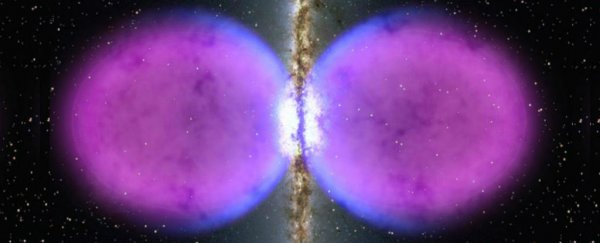Roughly 95 percent of the Universe and everything in it is made of dark matter and dark energy - things that have to exist for the Standard Model of Physics to make sense, but no one has any idea what they actually are.
But a supercomputer might, because scientists have just used one to write an outline of the particles that could form dark matter, and for the first time, it's predicted the weight of the axion - a hypothetical particle that's considered a prime candidate for the missing matter in the Universe.
The newly estimated weight of an axion - 10 billion times lighter than an electron - finally gives scientists something to use the search for a dark matter candidate, and researchers say it might even help us to detect direct evidence of them.
"[T]o find this kind of evidence, it would be extremely helpful to know what kind of mass we are looking for," says one of the team, Andreas Ringwald, from the Deutsches Elektronen-Synchrotron in Germany.
"Otherwise the search could take decades, because one would have to scan far too large a range."
Ringwald and his colleagues decided to zero in on axions, because they're one of the prime candidates for dark matter that have yet to be debunked.
It's thought that the unknown form of matter in the Universe can either be made up of few very heavy particles, or a lot of very light ones, and axions fit into this second category.
Axions are hypothesised to be low-mass, slow-moving particles that don't have any charge and interact very weakly with other matter.
This makes them difficult to detect, but the fact that they might be interacting with other matter at all means we should be able to detect them using the right equipment - if we know where to look.
Axions came about as a prime candidate of dark matter thanks to an extension of quantum chromodynamics, the quantum theory that's thought to govern strong nuclear force - one of the four fundamental forces of our Universe.
Quantum chromodynamics predicts the existence of a very weakly interacting particle, whose mass depend on the strength of quantum fluctuations in the fabric of spacetime. If you think that sounds vague and sort of like finding a needle in a haystack on a quantum scale, you're right.
That's where the JUQUEEN (BlueGene/Q) supercomputer in Germany comes into play. The team needed something that could handle the mind-melting numbers of variables needed to profile an axion.
The computer predicted that if axions do make up the bulk of dark matter, they should have a mass of 50 to 1500 micro-electronvolts, which would make them 10 billion times lighter than an electron.
That means if matter were spread evenly throughout the Universe, every cubic centimetre of the Universe would contain, on average, 10 million axions.
But dark matter doesn't appear to spread itself evenly - it forms clumps, like in this galaxy, made from 99.99 percent dark matter. That means our local region of the Milky Way would contain a whopping 1 trillion axions per cubic centimetre.
The researchers hope that now that they've narrowed down the hunt, physicists can prove or disprove the existence of axions once and for all.
"The results we are presenting will probably lead to a race to discover these particles," says one of the team, Zoltán Fodor, from the University of Wuppertal in Germany.
Game on.
The research has been published in Nature.
